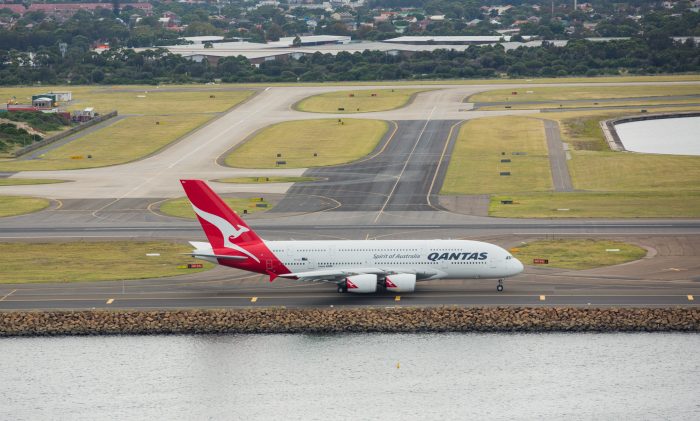
One of our A380s taxiing along side runway 34 Left at Sydney – the end of runway 34 Right can be seen in the background linked by a double taxiway.
Runways – they’re at the heart of every airport and can be made from concrete, grass and even ice.
Some are more than four kilometres long and can be up to 60 metres wide. These huge pieces of infrastructure are designed to withstand the enormous pressures of continuous aircraft landings.
So what are they made of?
First of all there’s a deep layer of sand, then a base of crushed rock or stone. This is then topped with a thick slab of concrete before a final layer of asphalt is sealed on top.
It sounds like any old highway but the foundations are very deep and it needs to be strong enough to absorb the weight of a 300 tonne Boeing 747 landing.

Groove is in the heart (of the runway). Photo credit: NYC Aviation
Walking along a runway (not recommended for obvious reasons) you’d see the surface is made up of grooves running horizontally along the surface.
This helps drain water from the runway when it’s raining to stop an aircraft slipping or aquaplaning so that the tyres are able to get enough grip.
So now we know what they’re made of – what about their names?
Around the world, runways are numbered from 01 to 36, usually painted in massive letters at either end. But the numbers have nothing to do with how many runways are at that airport.
They refer to the angle of the runway, like degrees on a compass. Our friends over at Airservices Australia break it down like this:
- A runway numbered 09 is angled to the east (90 degrees)
- A runway numbered 18 is angled south (180 degrees)
- A runway numbered 27 is angled west (270 degrees)
- A runway numbered 36 is angled north (360 degrees)
Some airports might have several runways all running parallel and in the same direction – so if there’s three, the outside one will be called 27 Left, then 27 Centre and finally 27 Right.
Atlanta’s Hartsfield Jackson Airport has five parallel runways which allows them to have three aircraft landing at the same time with two runways used for take offs.

This is an aerial view of Atlanta Hartsfield International Airport which has five parallel runways – only four are visible in this photo.
So how does all this work in practical terms. If you ever tune into air traffic control radio (and there’s an app for that), you’ll hear the air traffic controller say to a pilot something like “QF21 clear to land on runway 34 left”. This means that there’s two runways running in parallel so the one on the left is to be used by the aircraft for landing.

A Qantas A380 ready to turn onto runway 34L (you can see the giant numbers just before the white stripes) which is the main north south runway at Sydney. Runway 34R is commonly referred to as Sydney’s third runway and is south-east of 34L.
And once the aircraft touches down it’s directed off the runway onto a series of taxiways, these are like side streets that allow aircraft to manoeuvre around the airfield.
It’s the job of the controllers in the airport tower to make sure everyone stays on course.
One of the longest taxi routes in Australia is down to the southern end of runway 34R which is Sydney’s third runway.
Over at Tullamarine, it can just take a minute for an aircraft to taxi the short distance from gate 23 onto runway 27 for an express take-off.
In our next post, we’ll explain where the sweet spot is for landing and how pilots use a sophisticated system of lights to help them ensure a safe arrival.
For more Roo Tales click here.